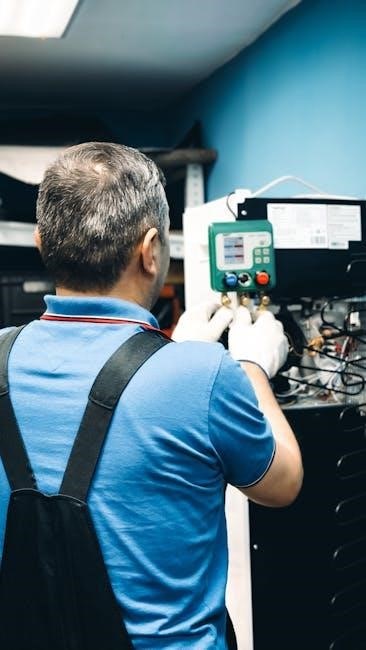A thermostatic expansion valve (TXV) is crucial for regulating refrigerant flow, ensuring optimal system performance. Proper adjustment maintains correct superheat, preventing inefficiencies and potential system damage.

What is a Thermostatic Expansion Valve?
A thermostatic expansion valve (TXV) is a critical component in refrigeration and air conditioning systems, regulating the flow of refrigerant into the evaporator. It operates by maintaining a precise balance between the pressure exerted by the refrigerant bulb and the spring force within the valve. This balance ensures the proper amount of superheat at the evaporator outlet, which is essential for efficient system performance. The TXV consists of three main components: the power assembly, cage assembly, and flange. It is designed to adjust automatically in response to changes in system conditions, such as temperature and pressure, ensuring optimal refrigerant flow. Proper TXV operation prevents issues like overflooding or insufficient cooling, making it a vital part of modern refrigeration systems. Understanding its function is key to effective system maintenance and troubleshooting.
The Importance of Proper Adjustment
Proper adjustment of a thermostatic expansion valve (TXV) is essential for ensuring optimal system performance and efficiency. Correct adjustment ensures the right amount of superheat at the evaporator outlet, preventing issues like overflooding or insufficient cooling. Improper adjustment can lead to reduced system efficiency, increased energy consumption, and potential damage to the compressor or other components. By maintaining the correct superheat setting, the TXV ensures consistent refrigerant flow, which is critical for reliable operation. Proper adjustment also prevents premature wear on system parts and helps maintain desired temperature levels. Regular and accurate TXV adjustment is vital for sustaining peak performance, minimizing operational costs, and extending the lifespan of the refrigeration or air conditioning system. It ensures that the system operates safely and efficiently under varying load conditions.
Common Applications of TXVs
Thermostatic expansion valves (TXVs) are widely used in various refrigeration and air conditioning systems. They are commonly found in residential and commercial HVAC systems, including refrigerators, freezers, and air conditioning units. TXVs are also used in industrial refrigeration setups, such as cold storage facilities and food processing plants. Additionally, they are integral components in heat pumps and automotive air conditioning systems. Their ability to regulate refrigerant flow based on superheat makes them ideal for systems requiring precise temperature control. TXVs are particularly effective in low-temperature applications, where maintaining consistent evaporator performance is critical. They are also utilized in systems with variable load demands, ensuring efficient operation across different conditions. Overall, TXVs are essential in any system that requires accurate and dynamic refrigerant flow control to maintain optimal performance and efficiency.

Components of a Thermostatic Expansion Valve
- The power assembly regulates refrigerant flow based on temperature changes.
- The cage assembly houses the valve’s internal components.
- The flange provides structural support and connects the valve to the system.
Power Assembly

The power assembly is the heart of the TXV, comprising a diaphragm, spring, and valve. It responds to temperature changes, adjusting refrigerant flow to maintain superheat. This component is crucial for system efficiency and performance.
Cage Assembly
The cage assembly houses the valve and spring, ensuring proper alignment and operation. It guides the valve’s movement, influenced by the power assembly, to regulate refrigerant flow accurately. This component is vital for maintaining precise control over system performance and efficiency.
Flange
The flange is a critical component of the TXV, serving as the mounting interface for the valve. It provides a secure connection to the system, ensuring proper alignment and sealing. Unlike the cage assembly, the flange contains no moving parts and does not require adjustment. Its primary role is to facilitate installation and maintain structural integrity. The flange design varies depending on the application, with some models featuring external or internal equalizers. Proper installation of the flange is essential to prevent leaks and ensure optimal system performance. The flange’s simplicity contributes to the overall reliability of the TXV, as it does not require maintenance beyond initial setup. This design ensures long-term durability and consistent operation under various operating conditions.

How a TXV Operates
A TXV regulates refrigerant flow by balancing pressure and temperature. It uses a power assembly and cage to adjust the valve opening, controlling refrigerant entry into the evaporator.
Superheat is maintained by sensing temperature and pressure, ensuring efficient system performance across varying conditions.
Principle of Operation
The thermostatic expansion valve operates by regulating the flow of refrigerant based on the temperature and pressure of the evaporator. At the heart of the TXV is a pressure-actuated diaphragm, which responds to changes in the evaporator’s superheat. As the refrigerant enters the evaporator, the TXV’s temperature-sensing bulb monitors the gas temperature at the evaporator outlet. This information is used to adjust the valve’s opening, ensuring the correct amount of refrigerant is allowed into the evaporator. The valve’s operation is balanced by the pressure exerted by the spring and the pressure from the evaporator, creating a precise control mechanism. This principle ensures efficient refrigeration by maintaining optimal superheat levels, which are crucial for system performance and longevity. Proper adjustment of the TXV is essential to achieve this balance and prevent issues such as overcharging or undercharging of refrigerant.
Role of Superheat in TXV Functionality
Superheat is a critical parameter in the functionality of a thermostatic expansion valve (TXV). It is defined as the difference between the refrigerant’s actual temperature and its saturation temperature at a given pressure. The TXV uses superheat to regulate the flow of refrigerant into the evaporator, ensuring that only vapor enters the compressor. Proper superheat levels prevent liquid refrigerant from flowing back into the compressor, which can cause damage. The TXV adjusts its opening based on the superheat measured by the temperature-sensing bulb at the evaporator outlet. Maintaining the correct superheat ensures efficient operation, prevents system inefficiencies, and avoids potential damage to the compressor. If superheat is too low, it can lead to liquid floodback, while excessive superheat reduces system capacity and efficiency. Thus, superheat is the cornerstone of TXV functionality and system performance.
Difference Between TXV and Other Expansion Valves
Thermostatic expansion valves (TXVs) differ significantly from other types of expansion valves in their operating mechanism. Unlike fixed orifice or capillary tubes, TXVs actively regulate refrigerant flow based on superheat. They use a temperature-sensing bulb to adjust the valve opening, ensuring optimal refrigerant flow. Other expansion valves may not provide this dynamic control, leading to less efficient operation. TXVs are more precise in maintaining the balance between liquid and vapor refrigerant, which is essential for high-performance systems. This adaptive capability makes TXVs superior in applications requiring precise temperature control, especially in larger or more complex systems. Their ability to adjust to varying load conditions sets them apart from passive expansion devices, ensuring better system efficiency and reliability. This dynamic regulation is a key advantage of TXVs over other expansion valve types.

Installation Guidelines for TXVs
Proper installation ensures optimal TXV performance. Select the correct capacity, use external or internal equalizers as needed, and follow manufacturer instructions for upright mounting and connections.
Selection of Correct TXV Capacity

Selecting the right TXV capacity is vital for system efficiency. Capacity depends on the evaporator’s temperature range and refrigerant flow requirements. Refer to manufacturer catalogs, like Parker Sporlan’s, for guidance. Ensure the valve matches the system’s tonnage and application, whether it’s for low-temperature settings or larger units. Using the wrong capacity can lead to poor performance or system damage. Always consult application bulletins and sizing charts to confirm compatibility. Proper selection ensures balanced refrigerant injection, optimizing superheat control and overall system performance.
Proper Installation Techniques
Proper TXV installation ensures optimal performance and longevity. Install the valve upright with the power element at the top, as specified in manufacturer instructions. Ensure the evaporator is compatible, especially for systems requiring external equalizers. Avoid incorrect orientations that may disrupt refrigerant flow. Secure all connections tightly to prevent leaks. Follow torque specifications for connections to avoid damage. Use appropriate tools for adjustments and ensure the valve is accessible for future maintenance. Verify the system’s pressure and temperature settings align with the TXV’s design parameters. Proper installation techniques prevent common issues like insufficient cooling or refrigerant underflow, ensuring efficient system operation and reliability.
Importance of External or Internal Equalizer
The equalizer in a TXV system ensures balanced pressure, crucial for accurate refrigerant flow regulation. External equalizers are typically used in systems with liquid distributors to maintain proper pressure at the evaporator inlet. Internal equalizers simplify installation but are less flexible. The correct selection prevents issues like over or underfeeding of refrigerant. Proper equalization ensures stable system operation, optimal superheat, and efficient cooling. Incorrect equalizer configuration can lead to performance degradation or system malfunction. Always consult the manufacturer’s guidelines to determine the appropriate equalizer type for specific applications. This ensures the TXV operates within design parameters, maintaining system efficiency and reliability. Proper equalizer setup is vital for achieving optimal TXV performance and system-wide functionality.

Adjustment of Thermostatic Expansion Valve
Adjust the TXV by turning the regulating screw with a spanner. Clockwise closes the valve, increasing discharge gas temperature, while anticlockwise opens it, decreasing temperature.
Tools Required for Adjustment
To adjust a Thermostatic Expansion Valve (TXV), you will need specific tools to ensure accuracy and safety. A spanner or adjustable wrench is essential for turning the regulating screw, which controls the valve’s opening and closing. An Allen key (specifically sized for your TXV) may also be necessary for accessing internal components. A manifold gauge set is required to measure system pressure, helping you determine the correct superheat setting. A vacuum pump is used to evacuate the system before adjustment, ensuring no contaminants interfere with the process. Thermometers or a digital temperature gun are needed to measure temperatures at key points, such as the suction line. Always refer to the service manual for your specific TXV model, as it provides detailed instructions and guidelines. Additionally, wear personal protective equipment (PPE) like safety glasses and gloves. An adjustable wrench and clamp-on ammeters or multimeters may also be useful for system checks. Having access to resources like the Danfoss TEV manual can provide further clarification and troubleshooting tips.
Step-by-Step Adjustment Process
Adjusting a Thermostatic Expansion Valve (TXV) involves a systematic approach to ensure proper system performance. Begin by evacuating the refrigeration system to remove any contaminants. Next, set the desired superheat based on the system’s specifications. Locate the TXV’s regulating screw, typically accessed with a spanner or Allen key. Turn the screw clockwise to increase superheat (closing the valve) or counterclockwise to decrease it (opening the valve). Use a manifold gauge to monitor system pressure and adjust accordingly. After each adjustment, allow the system to stabilize before rechecking the superheat. Fine-tune the screw until the desired superheat is achieved. Finally, secure the adjustment and recheck the system under normal operating conditions to ensure stability. Always refer to the manufacturer’s guidelines for specific instructions tailored to your TXV model;
How to Measure and Set Superheat
To measure superheat, use a manifold gauge set to determine the suction line pressure. Convert this pressure to a saturation temperature using a pressure-temperature chart. Place a thermometer at the evaporator outlet to measure the refrigerant’s actual temperature. Subtract the saturation temperature from the actual temperature to find the superheat. Aim for a superheat of 8-12°F for most systems. Adjust the TXV by turning the regulating screw clockwise to increase superheat or counterclockwise to decrease it. Ensure the system operates under normal conditions during measurement. Proper superheat adjustment ensures efficient system performance and prevents potential damage from incorrect refrigerant flow.

Troubleshooting TXV Issues
Common symptoms of TXV misadjustment include improper superheat, reduced system performance, and refrigerant flow issues. Check for correct installation and external factors before diagnosing TXV failure.
Common Symptoms of Misadjustment
Common symptoms of TXV misadjustment include abnormal superheat levels, reduced cooling capacity, and inefficient system performance. High superheat may cause reduced refrigerant flow, leading to inadequate cooling, while low superheat can result in liquid refrigerant floodback, damaging the compressor. Other signs include unusual noises, vibrations, or improper valve operation. Misadjustment can also cause erratic temperature control, insufficient dehumidification, or uneven airflow in HVAC systems. Additionally, the valve may restrict refrigerant flow excessively or allow too much, leading to system imbalance. If left unaddressed, these issues can escalate, causing premature wear on system components or even complete system shutdown. Recognizing these symptoms early is crucial for timely corrections and maintaining optimal system efficiency.
Diagnosing TXV-Related Problems
Diagnosing TXV-related issues involves a systematic approach, starting with understanding system symptoms and verifying superheat settings. Technicians should measure superheat at the evaporator outlet and compare it to the recommended range. High superheat indicates insufficient refrigerant flow, while low superheat suggests overcharging or restricted airflow. Pressure readings at the valve’s inlet and outlet can reveal internal blockages or excessive pressure drops. Visual inspections for frost accumulation or liquid refrigerant at the evaporator inlet are also essential. Additionally, checking the bulb sensor placement and ensuring proper system charge are critical steps. If symptoms persist after basic checks, internal valve examination or replacement may be necessary. Danfoss and Sporlan recommend eliminating other system issues before concluding TXV malfunction, as two-thirds of returned valves operate correctly. A comprehensive, system-wide approach ensures accurate diagnosis and effective troubleshooting.
System-Wide Approach to Troubleshooting
A system-wide approach to troubleshooting TXV issues ensures comprehensive diagnosis and effective resolution. Begin by evaluating overall system performance, including refrigerant charge, airflow, and evaporator operation. Check for symptoms like reduced cooling capacity or unusual noises, which may indicate broader system problems. Measure superheat and subcooling to identify imbalances, and inspect components like filters, capacitors, and contactors for faults. Pressure and temperature readings at key points help isolate issues. Verify proper installation of the TXV, ensuring correct orientation and connection. Consider external factors such as ambient temperature and system load, which can affect valve performance. By addressing potential causes beyond the TXV itself, technicians can avoid unnecessary repairs and ensure optimal system functionality. This holistic method aligns with manufacturer recommendations, emphasizing the importance of system-wide analysis over isolated component focus.

Maintenance and Care of TXVs
Regular cleaning and inspection of TXVs ensure optimal performance. Replace worn or damaged parts promptly to maintain efficiency. Schedule regular check-ups to prolong valve lifespan and system reliability.
Cleaning and Inspection
Regular cleaning and inspection are vital for maintaining the performance of thermostatic expansion valves (TXVs). Begin by gently brushing the valve’s exterior with a soft brush to remove dirt or debris. Inspect the valve’s internal components, such as the diaphragm and spring, for signs of wear or damage. Ensure the sensing bulb and capillary are clean and free from obstructions, as they are critical for accurate temperature sensing. Check for blockages in the valve’s orifice or evaporator inlet, as these can disrupt refrigerant flow. Additionally, verify that the valve is properly seated and aligned to avoid leaks or misoperation. Clean or replace any faulty parts immediately to prevent system inefficiencies or failures.
Replacing Worn or Damaged Parts
Replacing worn or damaged parts in a thermostatic expansion valve (TXV) is essential to ensure optimal system performance. Begin by identifying the faulty component, such as the power element, diaphragm, or spring. Use a spanner to carefully remove the adjusting screw and spring guide. Replace the worn part with a new one, ensuring compatibility and correct installation. Reassemble the valve in the reverse order of disassembly, making sure all connections are secure. After replacement, adjust the superheat setting according to the manufacturer’s guidelines to maintain proper refrigerant flow. Regular replacement of worn parts prevents system inefficiencies, reduces the risk of refrigerant leaks, and extends the lifespan of the TXV. Always refer to the manufacturer’s instructions for specific replacement procedures and safety precautions.
Regular Check-ups for Optimal Performance
Regular check-ups are vital to maintain the optimal performance of a thermostatic expansion valve (TXV). Inspect the valve for signs of wear, corrosion, or refrigerant leaks. Ensure the bulb is properly attached and not damaged, as this directly affects superheat regulation. Check the superheat setting and adjust if necessary to match the manufacturer’s recommendations. Verify that the power element is functioning correctly and replace it if it shows signs of deterioration. Clean the valve and surrounding areas to prevent debris from affecting performance. Schedule these inspections annually or as recommended by the manufacturer. Regular check-ups help prevent system inefficiencies, reduce energy costs, and extend the lifespan of the TXV. Always refer to the manufacturer’s guidelines for specific maintenance recommendations tailored to your system.
Proper TXV adjustment is crucial for system performance and efficiency. Skilled technicians, using the right tools and guidelines, ensure optimal functionality and long-term reliability.
A thermostatic expansion valve (TXV) is essential for regulating refrigerant flow, ensuring proper superheat levels for efficient system operation. Correct adjustment is vital to maintain optimal performance, prevent inefficiencies, and avoid potential system damage. TXVs are widely used in refrigeration and air conditioning systems, with applications ranging from low-temperature evaporators to large-capacity units. Proper installation, including selecting the right valve capacity and using external or internal equalizers, is critical. Understanding the role of superheat and how to measure it ensures accurate adjustments. Troubleshooting TXV issues requires a system-wide approach, as misdiagnosis is common. Regular maintenance, including cleaning and inspections, ensures long-term functionality. By following these guidelines, technicians can optimize TXV performance, leading to improved system reliability and efficiency.
Importance of Proper TXV Adjustment
Proper adjustment of a thermostatic expansion valve (TXV) is critical for ensuring optimal system performance and efficiency. Correct superheat settings prevent excessive refrigerant flow, which can lead to reduced cooling capacity and increased energy consumption. Misadjustment can cause system-wide issues, such as poor temperature control, higher operating costs, and potential equipment damage. Additionally, improper adjustment may result in premature wear of system components, leading to costly repairs. By maintaining precise superheat levels, TXVs ensure balanced refrigerant flow, maximizing system efficiency and longevity. Regular checks and adjustments by qualified technicians are essential to uphold these benefits and prevent operational disruptions.
Additional Resources for Further Learning
For deeper understanding, consult manufacturer manuals like Danfoss TEV guides, which detail installation, adjustment, and troubleshooting. Sporlan and Parker Sporlan catalogs offer comprehensive application data. Online tutorials and DIY guides provide step-by-step adjustment instructions. Industry forums and training programs by HVAC professionals share real-world experiences and best practices. Technical documents from leading manufacturers and educational articles on refrigeration systems expand knowledge on TXV functionality. These resources ensure technicians and enthusiasts can master TXV adjustment, troubleshooting, and maintenance for optimal system performance and efficiency.
